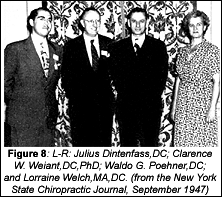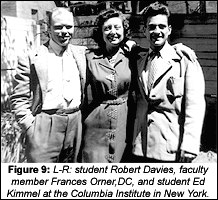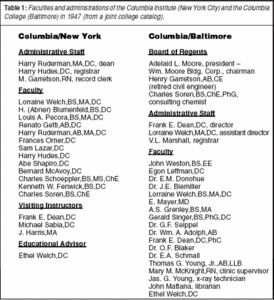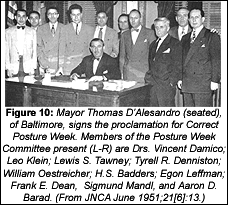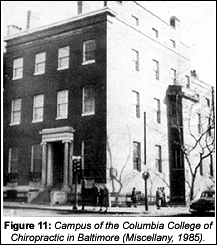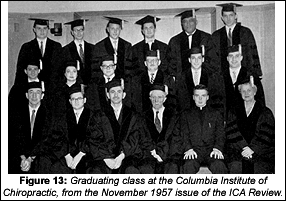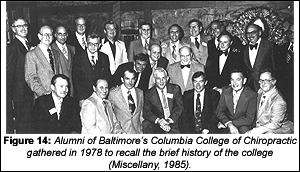| It is now almost fifty years since chiropractic was born. In spite of persecution, all kinds of opposition from the "regulars" and in spite of the blunders committed by our own practitioners, the science of chiropractic is now known throughout the entire world. There is not one point on this globe that does not know of the wonderful results obtained through this science. Because of our wonderful achievements in the health field, it is now generally recognized that chiropractic is a necessity in the healing arts. We can now boast of hospitals, sanitariums and grade-A colleges - the latter are not interested in sending out hordes of graduates into the field, but in painstakingly and carefully eliminating the undesirable student in the beginning. This is as it should be, as we know that true success and happiness can only be accomplished if we are temperamentally and academically suited for this profession. Through our latest research, we find that there is only a very small list of diseases that cannot be successfully treated through chiropractic. Well I remember a statement by a professor in one of the western colleges that I attended, "To be a profession in the full meaning of the word, a calling must fulfill the following requirements: First of all, it must be of direct service to humanity; it should have literature worthy of a learned profession; it should have a definite sense of properties as manifested by a code of ethics; it should embrace within its fold a group of persons, that are scientifically trained and who are qualified to do research; it must demand proper educational standards, sufficient to obtain ample knowledge in the sciences upon which the practice of the profession is based." Now we are proud to be called doctors of chiropractic, as we are respected in our communities and placed into the ranks of public benefactors, and here are a few proofs: Andrew J. Sordoni, senator of Pennsylvania, states: "Chiropractic science is of inestimable value to the people in Pennsylvania." Governor H. Moore of New Jersey: "We do have many chiropractors in our state, and they must be rendering service to suffering humanity or they would not be able to continue." The honorable Judge J.B. Heiserman, of Pennsylvania, goes on record that: "Chiropractic, indeed, is of great value." Congressman William Barry: "Chiropractic has helped many where no other methods could." I am also happy to say that our national, state, and county chiropractic organizations are cooperating for once in educating the public at large to the value of chiropractic; insisting that its members obtain additional information on the newest developments in our science; setting up offensive, and defensive campaigns against our common enemies. Time Marches On! (Dean, 1939) |
Despite these noble sentiments, Dean was among those college leaders who banded together during the NCA's 1939 convention in Dallas to form the Allied Chiropractic Educational Institutions (ACEI), an agency that opposed the educational reform efforts of the NCA (Keating, et al., 1998; Ratledge, 1939). Although Dean apparently never attended the meetings of the ACEI (Dean, 1944), sending representatives or proxies instead (e.g., Allied, 1940; Ratledge, 1940a,b), he lent his name to the ultimatum the alliance issued in July 1940:
To the National Chiropractic Association, the Chiropractic Health Bureau, and all allied organizations purporting to be within the chiropractic profession, the Allied Chiropractic Educational Institutions goes on record and states that unless a reorganized plan of your bodies, association, or by whatever name known, reorganized, amend and change said organizations in such way as to be in conformity with the suggestions and demands of allied educational institutions, we find it is necessary that we shall withdraw all support that has ever come from the members of this organization to your organization in every way, shape and manner, and we say to you now in all kindness and truth that unless reorganization, amendments, etc., are accomplishments by you within a reasonable time, the members of the Allied Chiropractic Educational Institutions shall feel free to organize a separate national organization that will be strictly chiropractic in all of its departments, and will look to carrying out, all and singular, the things that have been said in this address. This matter has been fully considered and unanimously passed by this organization, which has signed the same as such and each of its members has signed in his individual capacity. Dated this 20th day of July, 1940Allied Chiropractic Educational Institutions Per TF Ratledge,DC, secretary, Jas. R. Drain, acting president (Allied, 1940). |
The Columbia Institute was not among the schools granted "provisional, approved" ratings by the NCA Committee on Education in August 1941 (List, undated), but was among those NYC-based colleges that John J. Nugent,DC, NCA's director of education, expected to merge (Nugent, 1943) to create what became the nonprofit Chiropractic Institute of New York (CINY). As it turned out, the CIC was not among the schools that participated in the 1944 amalgamation. Historian William S. Rehm,DC, who briefly attended the later, Baltimore branch of Columbia, recalled "seeing Nugent on campus at least twice, and witnessed a wild debate between he (Nugent) and others over Columbia's quest for NCA accreditation. (The school was ICA-approved.)" (Rehm, 1996).
| Dean's reasons for not participating in CINY's formation remain unknown, and the CIC would compete for students with CINY for the next quarter century. Dean joined with several straight college leaders, including Palmer, Ratledge, Willard Carver,LLB,DC, and Carl S. Cleveland, Sr.,DC, in opposing the initiatives of the Council of State Chiropractic Examining Boards to rate/accredit chiro schools (Ratledge, 1945a). As well, he contributed financially to Ratledge's lawsuit against the California Board of Chiropractic Examiners (Ratledge, 1945b), which had attempted to raise educational requirements for licensure in the Golden State without statutory authority (Keating, et al., 1991). World War II took a toll on CIC's enrollment (Ratledge, 1945b), but Dean set his sights on the anticipated approval of chiropractic schools for veterans' educational benefits in the postwar era. In 1946 he organized the Columbia College of Chiropractic (CCC) in Baltimore, and on August 19 received "temporary approval by the Maryland State Department of Education" (Nugent, undated). Rehm (1996) recalled: Dean did not "organize" the school in a vacuum. Chances are the trustees were planning the branch operation well before the war ended. After all, the new school would be taking advantage of G.I. benefits. (I'm not sure if the New York school qualified.) A facility has to be purchased, inspected and approved by the V.A. There was also paperwork to file with the state department of education and the chiropractic board. A faculty had to be in place, students recruited, etc., etc... The new school opened on September 3, 1946 as the Columbia Institute of Chiropractic-Baltimore. In '48, CIC became the independently chartered Columbia College. A much larger facility was leased in '49 while a search began for permanent quarters. (The original building was still owned by the corporation.) There was serious discussion of purchasing a small residential hotel and one or more buildings of a women's college that was relocating to the suburbs. A fundraising effort was started. The faculty, all part-time, was well-paid - over $40 an hour, depending on academic qualifications. It was a great source of supplemental income. I suspect the "good pay" was at the root of much resentment against the college. It is a fact that the board of examiners and the state association always opposed Columbia....lots of intrigue... I'm sorry there isn't a Columbia still here. I should do a paper about it. |
Rehm's compensation figures may be too high; Michael Moross,DC, recalled that he was paid $10 per hour for his classwork.
The 1946 formation of the CCC created dissatisfaction at the parent school in NYC. Future ACA governor Edwin H. Kimmel transferred from CIC to CINY "because Dean took all his visual aid equipment and books from the library to his Maryland school" (Kimmel, 1995b), a tactic that "infuriated many of us who were going to school under the auspices of the G.I. Bill just after World War II. That was 1946/1947" (Kimmel, 1995a). Harry Ruderman,MA,DC, was recalled as "an asset to the school" (Moross, 2002c), and assumed Dean's role at the NYC branch (see Table 1). Tuition for the four-year (40-month) course at either school was $400 per year. Dean's wife, Lorraine Welch,MA,DC, who had served as registrar of CIC since 1930 and would earn a PhD from New York University in 1956 (Rehm, 1980, p. 332), served as assistant director of the new college in Baltimore, but was also listed on the faculty in New York. Like other faculty members (e.g., Michael Moross,DC), she may have commuted between the two institutions.
| According to a 1947 college catalog, the new school in Baltimore was initially located at 511 Cathedral Street, but a new campus at 119 West Franklin Street, "in the shadow of the famed Pratt Library" (Miscellany, 1985), was announced in the autumn of 1949 (School, 1949). A 1953 announcement once more placed Columbia College at 511 Cathedral Street (Columbia, 1953). Rehm mentioned additional locations in a discussion of Dr. Dean's Baltimore activities, including a straight/mixer confrontation and Dean's introduction of physiotherapy to the curriculum: Frank Dean... was a dedicated and disciplined educator. I don't know what he was paid as president of two institutions, but he gave back plenty, especially to Columbia in Baltimore. When I arrived as a student in 1951, the postwar boom was already wearing off and the new two-year pre-pro(fessional) entrance requirements certainly didn't help. Still, the NCA considered Columbia of Baltimore - "the best of the nonaccredited schools" - worth saving. With an infusion of NCA matching dollars, CCC would begin teaching the "forbidden" modalities and install a human dissection lab, among other things. In the spring of 1953, an open meeting took place at a Baltimore hotel to discuss proposed improvements to curriculum and plant. John Nugent was there for the NCA, but the ICA turned out in force. What should have been a straightforward presentation quickly degenerated into a chaos of shouting and personal insults hurled by the ICA group. My father, an attorney who attended the meeting with me, couldn't believe what he was witnessing. That rancorous meeting is an untold story of chiropractic's absurd paranoia. Details might yet exist in the NYCC archives, but probably not. One of the possible scenarios for the cash-energized CCC was to sell its two downtown properties and purchase a large (five-story) building in Baltimore's midtown, vacated by a women's college that had recently removed to the suburbs. Columbia College of Chiropractic could have survived and flourished. But it didn't happen, of course. What happened to the buildings? 807 Cathedral Street, which the school originally occupied and quickly outgrew, was sold and ever since occupied by an engineering firm. 119 West Franklin Street was torn down years ago for a parking lot. The Enoch Pratt Library for the Blind was eventually built there. The handsome former women's college that might have become CCC is still there, but vacant. It had been occupied by the Central Maryland Red Cross until it, too, fled to the suburbs. In this whole story, fleeing seemed the simplest answer... (Rehm, 2000). |
| The school was granted temporary approval by the Maryland State Department of Education on August 19, 1946, contingent upon twelve conditions. After seven years of conferences, extensions of time and advice, the Department of Education was compelled to withdraw its accreditation (Nugent, undated). |
Notwithstanding this forced closure, Dean engendered affection and loyalty among many of his students and graduates at both Columbia schools, sentiments that persist to this day (e.g., Cooper, 2002; Nimhauser, 2002). However, as Columbia closed its doors in Baltimore, Frank Dean was nearing the end of his career. On May 12, 1958, he passed away (Rehm, 1980, pp. 298, 332). His successor, 1942 Palmer alumnus Ernest G. Napolitano,DC (Columbia, 1969), was appointed president of CIC some 18 months later.
Founder of three chiropractic schools, mentor to thousands of chiropractors, and chief executive officer (by whatever title) of the Columbia Institute for nearly 40 years, Frank E. Dean, DC,PhC, must be recognized as one of the pioneers in chiropractic education. Yet his life remains largely a mystery, seemingly concealed by his own hand. Whether further information can be retrieved from surviving school records at NYCC's Seneca Falls campus or elsewhere remains to be seen. All that is certain is that the mysterious Dr. Dean merits further investigation.
References
- Advertisement: Columbia Institute of Chiropractic. The Chiropractic Journal (NCA) February 1933 (Feb); 1(2): 24
- Advertisement: Columbia Institute of Chiropractic. The Chiropractic Journal (NCA) 1937 (Sept); 6(9): 37
- Advertisement: Columbia Institute of Chiropractic. The Chiropractic Journal (NCA) 1938 (Jan); 7(1): 41
- Allied Chiropractic Educational Institutions. In the matter of the preservation of chiropractic. Kansas City MO: ACEI, 20 July 1940 (white paper) (Ratledge papers, Cleveland Chiropractic College of Kansas City)
- Annual announcement. New York City: Columbia Institute of Chiropractic, undated (circa 1930)
- Beideman, Ronald P. In the making of a profession: the National College of Chiropractic, 1906-1981. Lombard IL: National College of Chiropractic, 1995.
- Buffalo, N.Y., July 1-6. Bulletin on the American Chiropractic Association 1929 June;6(3):4.
- Chiro defeats physician in debate on vaccination. New York Graphic, 28 April 1927.
- Columbia College moves. ICA International Review of Chiropractic 1953 Apr; 7(10):26.
- Columbia Institute of Chiropractic...fifty years of progress. Digest of Chiropractic Economics 1969 Sept/Oct; 12(2):26-7.
- Cooper, Charles N. Letter to the editor. Journal of the American Chiropractic Association 2002 May;39(5): 26.
- Dean, Frank E. Time marches on. National Chiropractic Journal 1939 Jan;8(1):44.
- Dean, Frank E. Letter to T.F. Ratledge,DC, 20 June 1944 (Ratledge papers, Cleveland Chiropractic College of Kansas City).
- Directory of chiropractic schools and colleges. ICA International Review of Chiropractic 1954 Aug;9(2):6-7.
- Drugless healers mass to fight persecutions. New York Graphic, 26 April 1926a.
- Drugless cults organize to fight for recognition. New York Herald Tribune, 2 May 1926b.
- Goldschmidt, Sol. A brief history of chiropractic in New York state, 1902-1963.
- NYSCA Journal 1994-95a Winter;22(5): 20-3.
- Goldschmidt, Sol. A brief history of chiropractic in New York state, 1902-1963.
- NYSCA Journal 1995b Spr; 23(1): 17-22.
- Inquiry resumed into chiropractic. New York Times, 9 April 1926.
- Keating JC. Craig M. Kightlinger,MA,DC and the Eastern Chiropractic Institute, 1916-1944. Journal of Chiropractic Humanities 1996:6:26-44.
- Keating JC, Brown RA, Smallie P. Tullius de Florence Ratledge: the missionary of straight chiropractic in California. Chiropractic History 1991 Dec;11(2):26-38.
- Keating JC, Callender AK, Cleveland CS. A history of chiropractic education in North America: report to the Council on Chiropractic Education. Davenport,IA: Association for the History of Chiropractic, 1998.
- Kimmel, Edwin H. Email to J.C. Keating, 4 November 1995a.
- Kimmel, Edwin H. Email to J.C. Keating, 22 December 1995b.
- Last-minute changes. The Chiropractic Journal (NCA) 1934 Aug;3(8):11.
- Lee, Lyndon E. Saving the bacon for New York State. National (College) Journal of Chiropractic 1923 Oct; 11(2):23-5.
- List of approved colleges, undated (1941) (CCE Archives).
- Lombardo, Dean M. William H. Werner and the American Bureau of Chiropractic: organizing a lay constituency. Chiropractic History 1990 June;10(1):24-9.
- Miscellany: Baltimore's Columbia College. Chiropractic History 1985;5:38.
- Moross, Michael. Email to J.C. Keating, 5 January 2002a.
- Moross, Michael. Email to J.C. Keating 8 January 2002b.
- Moross, Michael. Interview with J.C. Keating, 16 January 2002c.
- Nimhauser, Herman. Email to J.C. Keating, 20 January 2002.
- Nugent, John J. Report to the Executive Board of Directors and Committee on Educational Standards, 30 November 1943 (CCE Archives #35-12-1938).
- Nugent, John J. Memorandum; undated (circa 1954) (CCE Archives #26740).
- Official dedication & ribbon cutting, October 2, 1993, NYCC Museum of Chiropractic History (brochure).
- Palmer, B.J. Fountain Head News 1920 (A.C. 26) (Oct 16);10(5):8.
- Ratledge, T.F. Minutes of the Allied Chiropractic Educational Institutions, 26 July 1939 (in the author's possession).
- Ratledge, T.F. Letter to C.Y. Dean, president of Columbia Institute of Chiropractic, 8 August 1940a. (Ratledge papers, Cleveland Chiropractic College of Kansas City).
- Ratledge, T.F. Letter to Craig M. Kightlinger, DC, 9 August 1940b (Ratledge papers, Cleveland Chiropractic College of Kansas City).
- Ratledge, T.F. Letter to James R. Drain,DC, 22 March 1945a (Ratledge papers, Cleveland Chiropractic College of Kansas City).
- Ratledge, T.F. Letter to Frank E. Dean,DC, 28 November 1945b (Ratledge papers, Cleveland Chiropractic College of Kansas City).
- Rehm, William S. Who was who in chiropractic: a necrology. In Dzaman F, Scheiner
- S, Schwartz L (Eds.): Who's Who in Chiropractic, International. Second Edition. Littleton CO: Who's Who in Chiropractic International Publishing Co., 1980.
- Rehm, William. Letter to J.C. Keating, 14 December 1995.
- Rehm, William S. Letter to J.C. Keating, 26 February 1996.
- Rehm, William S. Letter to J.C. Keating, 7 May 2000.
- Robinson, Kelly C. Letter to Cleveland Chiropractic College, 19 January 1938 (Cleveland papers, Cleveland Chiropractic College of Kansas City).
- School affairs: Columbia College of Chiropractic. ICA International Review of Chiropractic 1949 Oct; 4(4):31.
- Standard's new school building to be credit to the profession. The Recoil 1921 Apr;1(4):1.
- Vernon, Leonard F. A Profession Persecuted: The History of Chiropractic in New Jersey. Davenport IA: Association for the History of Chiropractic, in press.
Joseph Keating Jr.,PhD
Click here for previous articles by Joseph Keating Jr., PhD.






